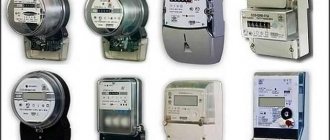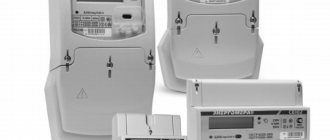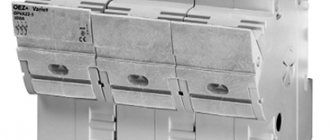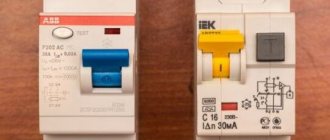Electrical plugs installed on the electric meter perform a safety function, protecting the home network from the danger of short circuit and overload. Many consumers still have outdated and unreliable fuses installed that do not fully perform their intended functions and constantly cause operational problems. Let's consider the types of electrical plugs used and the procedure for replacing outdated models with new models, taking into account the rules of calculation and selection.
Types of electrical plugs
The following types of fuses are produced:
- ceramic base type - an outdated model, where the safety function is performed by a fusible insert. If the load increases beyond the standard, the insert burns out and needs to be replaced. Often, consumers using such fuses, if there is no insert, install jumpers. This method of repair leads to the fact that the fuse ceases to perform its functions, which creates the danger of fire and failure of the electrical wiring;
Ceramic base type - automatic plinth – an improved model of the previous model. Allows you to turn off the network when the parameters are exceeded and then turn it on by pressing a button. Unreliable and short-lived, they quickly fail;
Base automatic - circuit breakers are modern devices that ensure network shutdown in emergency situations. Mounted on DIN rail.
Circuit breakers
The machines are characterized by a number of advantages:
- reliability and durability;
- the ability to select models with different current levels and response speeds;
- ease of use;
- quick and easy installation;
- compact size and attractive appearance.
We produce versions of circuit breakers equipped with a thermal relay that opens the electrical circuit when the temperature rises, which provides additional reliability.
RCD connection
In order to prevent people from being electrocuted by accidental contact with a bare section of the cable, as well as by a breakdown on the housing, it is advisable to include an RCD in the general network. The basis of the operation of the residual current device is constant monitoring of the balance of currents passing through the device. If an electric current leaks to the chassis or to the ground, an imbalance occurs. Having detected an imbalance, the device is triggered and de-energizes the circuit.
The rated current of the RCD is selected in the same way as for the input machine. The residual current device is connected to its output. It is recommended to check the performance of the RCD monthly - for this purpose there is a “Test” button on the device body. From the output terminal of the device, the phase is connected to the input of the first AV, and then through jumpers it goes to other switches. The neutral cables must be connected together with a bus block, then secured to the DIN rail.
If the connection is three-wire, then the grounding conductors are connected in the same way by a bus block. However, it should be noted that they should not be in contact with zero.
Why do traffic jams heat up?
Outdated models of electrical plugs often overheat, which can cause a fire. Overheating can be caused by the following reasons:
- insufficient contact on traffic jams;
- poor contact in sockets on switched on devices or connections in electrical wiring;
- excessive total power of switched on consumers;
- abnormal operation of household electrical appliances.
If such a situation occurs, it is necessary to immediately turn off the power to the home electrical network and identify the cause of the malfunction. To do this, you should conduct a complete audit of the wiring, checking the condition of the sockets and wire connections.
How to replace plugs with automatic machines in the electric meter in an apartment
Automatic machines are preferable for use in homes. What to do when replacing traffic jams with automatic ones:
- calculate the network load, and based on the data obtained, select an automatic machine;
- contact special services when opening the electric meter;
- carry out work to replace plugs.
Warning the electricity supply company is a mandatory step. Incorrect energy metering can result in a fine for the owner. To notify the service about a replacement, you need to:
- to write an application;
- invite representatives of electrical networks to record the readings of the old meter;
- carry out work to replace traffic jams;
- again invite company representatives to seal and connect the meter.
Step-by-step instructions for replacing plugs:
- turn off the electricity in the house;
- Unscrew the ceramic body and remove the protective casing;
- disconnect the wires and write down where the phase and zero are;
- install din rail;
- attach machine guns to it;
- connect the wires;
- perform a performance check.
You can install several switches. Separate circuit breakers with a high operating current are installed on powerful electrical appliances. The more switches are installed, the easier it is to find problems in the network.
Fuse selection procedure
To ensure uninterrupted and safe operation of the electrical network, fuses must be selected taking into account the expected operating conditions. To do this, the general power indicators of the operated devices are summed up.
A simple calculation example. In the house it is possible to simultaneously turn on the following electrical appliances with power indicators:
- refrigerator (450 W);
- electric stove (6000 W);
- microwave oven (2000 W);
- TV (180 W);
- washing machine (800 W);
- lighting devices (400 W).
The total value of the electric current is calculated using the formula:
A = ∑Р/U, where:
- A is the desired current value in amperes;
- ∑Р – the total power of electrical appliances, in this case equal to 450 + 6000 + 2000 + 180 + 800 + 400 = 9830 W;
- U – rated voltage value equal to 220 V.
Substituting the numbers into the formula, we get:
A = 9830/220 = 44.68 A.
Circuit breakers are manufactured with different current limit values. The closest standard model in terms of current is rated at 50 A.
Additionally, you will need to check the cross-section of the electrical wiring wires for the total power of electrical appliances in order to eliminate the risk of thermal overheating of the network. The indicator is checked against the table, depending on whether copper or aluminum wiring is used:
In the example given, the cross-section of the wires must be no less than:
- for copper – 6 mm;
- for aluminum – 10 mm.
If it turns out that the cross-section of the wire in the home network is less than specified, it is recommended to change the wiring to eliminate the risk of fire and failure.
It is recommended to purchase circuit breakers instead of outdated plugs. It is advisable to use a two-pole switch that turns off both phases simultaneously. If you install separate switches on the neutral and phase wires, when the contact at zero is disconnected, the phase will remain connected, which is associated with the risk of failure of electrical appliances.
Types of safety circuit breakers
There are circuit breaker designs that are used in home electrical circuits. The most common are electrical ceramic and automatic circuit breakers.
Electric ceramic
Older devices used ceramic plugs.
They were a porcelain cylinder with a conductor located inside. Under the influence of a greater than rated current, the metal heats up and breaks, breaking the circuit. Pros:
- reliability.
Minuses:
- disposable;
- triggered by a slight overcurrent;
- they take a long time to get out.
Today, such models are rarely used; users switch to automatic circuit breakers.
Automatic
An automatic stopper is similar in appearance to a ceramic breaker, but the operating principle is different.
Under the influence of a current exceeding the design load, the metal heats up, the spring increases and the fuse trips. Advantages:
- not disposable - to turn on the automatic stopper, you need to press the button on the body with your finger;
- ease of use.
Minuses:
- short service life;
- unreliable - automatic plugs heat up and sometimes do not work due to their design features.
It is better to use circuit breakers. They are durable, easy to use, reliable and compact.
Sequence of replacing electrical plugs
If the apartment has base-type plugs, you will need to redo the fastening design. The replacement procedure sequence is as follows:
- using a multimeter or an indicator screwdriver, the location of the phase and zero is determined;
- the power supply to the apartment is turned off;
- the base sockets of old fuses are removed;
- instead, a DIN rail is mounted to mount new switches. The rail is cut to the required size. For installation on a wooden or metal base, self-tapping screws are used; for concrete, you will need to insert dowels, having previously drilled holes in the intended locations;
- the circuit breaker is connected with the correct wiring. To avoid confusion, the neutral wire is marked with a tag with the letter N;
- wires are connected to the bottom of the device, supplying electricity to the home network;
- After connecting the contacts, the device is mounted on a DIN rail.
To ensure additional safety when operating the home electrical network, it is recommended to install a special device, an RCD, together with the circuit breaker. It will turn off the voltage if a person accidentally comes into contact with a bare wire.
The operating principle of an RCD is based on monitoring the value of electric current in the network. If a person accidentally comes into contact with a live wire, the current balance will be disrupted and the device will turn off the network.
The RCD is selected in the same way as a circuit breaker based on the maximum current value. If an RCD is installed, the owner must provide additional space on the DIN rail. The connection is made in the same way, with insertion and crimping of the phase and neutral cables into the installed connectors.
To ensure proper workmanship, fuse replacement must be carried out by a qualified electrician. If the homeowner does not have the proper skills, a specialist should be called in. In this case, the work will be completed correctly and safety will be ensured during its implementation.
In most cases, you will not need to remove the electric meter. But if the cables are arranged in such a way that the meter needs to be removed, you must first agree with the energy supply company to remove the seals. After the replacement has been made, it is necessary to invite inspectors to reinstall the seals on the meter.
Correctly installed circuit breakers to replace outdated electrical plugs will eliminate the danger of an unforeseen situation and ensure normal operation of the home network. The main thing is to choose fuses with parameters corresponding to the expected operating conditions. To purchase high-quality devices, you need to contact official trusted dealers and choose products from trusted manufacturers. It would not hurt the owner to first consult with a competent specialist regarding the choice of model and place of purchase of circuit breakers.
Replacing base-mount automatic circuit breakers with circuit breakers:
Replacing automatic traffic jams:
Installation of circuit breakers
After the network is de-energized, work is carried out in the following order:
- Remove the electrical plug holders.
- Install the DIN rail in their place. It must first be cut to fit the size of the switch. Fastening to wood or metal is done using screws, and when working with a concrete wall you need to use dowels.
- Connect the protective device. In this case, two current-carrying wires are connected from the top of the device (to avoid confusion, the letter N is marked on the terminal for connecting the neutral wire).
- From the bottom of the AB you need to connect the cables through which electricity is supplied to the home network to the installed devices.
- After the conductors are connected, the safety switch is placed on the DIN rail.
This completes the replacement, but this scheme can be improved somewhat, making it safe for humans.
Step-by-step instructions and dangers when replacing
Now let's look at the operating procedure itself. First, turn off the machine that needs to be replaced.
Although you will change it under voltage, but without load
Next, it is very important to determine which side the power comes from and which of the conductors you have remains energized
The power to the machine is not always supplied from above, so check both clamps with an indicator screwdriver. On one of them the light will glow, on the other it will not.
It is worth making an important digression here. If your circuit breaker is supplied with voltage through a comb bus, then I hasten to disappoint you - it’s easy and safe to replace one switch without de-energizing, you most likely won’t be able to
You will not be able to simply dismantle the old machine from this very bus without disconnecting it from all other devices in the chain. And this makes the task very difficult.
After you have found out where the power conductor is located, unscrew the screws with an insulated screwdriver. First, the one with no voltage. Then on the second one, where there is 220V.
What do professionals recommend doing here? When you unscrew the second screw, use pliers with your other hand, be sure to hold the core. At the moment the contact loosens, the conductor may jump out or spring back in the most unexpected direction.
You must anticipate and prevent this situation in advance. This is especially true in cases where the supply core is stretched by a branch from the nut from the access riser.
Without pliers with insulated handles, it is better not to touch the conductors in the switchboard. Even with gloves.
If this is not possible due to lack of space, then try to do all operations to move the conductors with one hand. The second one should be hidden behind the back.
If you do not unscrew the phase wire, but bite it out with side cutters, do it as far as possible from the metal strip in the panel. Since at the moment of cutting the wire, the blades of the cutters are automatically energized.
And if you accidentally touch any part of the body with them, there will be a big bada-boom! Since all metal parts in the electrical panel are a common zero. Accordingly, accidental contact with them will immediately cause a short circuit.
Moreover, in a common panel with meters of other apartments, this is a single-phase short circuit, which can quickly turn into an interphase one, with much more serious consequences.
After the dangerous wire is dismantled, a cambric, a piece of heat shrink is put on its end, or it is simply wrapped with electrical tape.
Your task is to isolate it in any way possible while you change the machine.
When replacing a three-phase input modular circuit breaker under voltage, all these operations are carried out alternately with each phase.
Just don’t forget to note and remember the phasing and the correct location of the phases.
When margin allows, move the disconnected conductor as far as possible. At the same time, be careful with its other end, with which it is connected, for example to a baggie or a nut in a riser.
With strong bends, the core may break off or simply jump out of a poorly clamped contact. And then you will have more business.
If such a problem does occur on a nut, then it will not be possible to reconnect the wire on it without extinguishing the entire riser. In this case, it is much safer to shell out a little and buy one piercing clip.
This is how the live input cable is connected to the SIP wires.
It has a special design with piercing teeth. Thanks to them, you don’t even have to remove the insulation from the main phase along the riser.
There are often cases when it is necessary to go through the entire 3-phase panel board in the entrance, but disconnections are not given.
In such a situation, you bite off the old bends from the riser, made on nuts, and throw away everything unnecessary. Then, without tension, calmly and safely, assemble the new circuit and reconnect everything to the riser through the piercing clamps.
But let's return to our machine. After removing the wires from it, remove the old machine according to the instructions described at the very beginning. Install a new one in its place.
First, connect the wire without voltage to it, and then, having removed the insulation (cambric, heat shrink) from the tip of the phase conductor, carefully insert it into the machine using pliers.
All that remains is to tighten the contacts well. Turn on the load and check the functionality of the device.
Shield diagram
We set ourselves the humble goal of replacing an outdated plug panel with a circuit breaker panel or box. Therefore, changes in the electricity metering panel layout will be minimal. The figure below shows what the original circuit looks like with plug-type fuses.
After modernization, we should have a circuit with a single-pole circuit breaker that protects all the electrical equipment of the apartment.
In both figures, the phase wire is indicated in brown and the letter L, the neutral wire is indicated in blue and the letter N.
It is not difficult to notice that in the new circuit, instead of two fuses, there is only one circuit breaker. A legitimate question arises: why were two protective devices replaced by one? The fact is that fuse links have a large technological spread, and the use of two fuses increases the reliability of electrical wiring protection. The circuit breaker controls the current with greater accuracy, since during the manufacture of circuit breakers the time-current characteristics and the protection threshold are checked. Therefore, one machine gun is enough. In addition, current rules prohibit breaking the neutral wire circuit with switching devices.
In apartment buildings, distribution boards are usually located on landings, where you can turn off the voltage supplied to the apartment. There is no such possibility in a private house. Therefore, in a private home, the energy supply organization may require that a disconnect device be installed before the meter. It is needed to safely replace the meter or service it.
In a single-phase network, two-pole disconnectors or circuit breakers can be used as a disconnecting device. Below is a diagram with a switch at the input.
To prevent theft of electricity, switches installed upstream of the meter are sealed by energy supply organizations. The switch drive, protective curtains or screens on the terminals are sealed. Therefore, when purchasing a two-pole switch, choose a model with the possibility of sealing.
When choosing between a disconnector and a circuit breaker, it is better to give preference to the disconnector. The fact is that it is impossible to turn on a triggered sealed machine without breaking the seal.
If you still want to protect the meter using a circuit breaker, then its rated current must be higher than the rated current of the switch installed after the meter. As an input circuit breaker, it is better to use a device with a protective characteristic of type D. Switches with this characteristic have a higher operating threshold in the event of a short circuit. The use of a type D machine will reduce the likelihood of both machines triggering simultaneously.
Reasons for needing replacement
The machine has two protective circuits at once - electromagnetic and thermal. The first circuit comes into operation when short circuits occur, the second circuit is activated when the network is overloaded. It can be especially difficult to recognize the cause of a circuit breaker failure after the thermal protection has tripped, because no visible defects are found on the equipment.
Much more often, signs of failure are evident; this is partial or complete burnout of the clamping contacts. Their unreliable connection is usually to blame. If soft aluminum was used, then problems will invariably appear in the future: the contact weakens due to the fact that the metal “floats”. To prevent an emergency, contacts need to be tightened several times a year.
The rarest reason is a manufacturing defect, which often “makes itself known” immediately after the switch is put into operation. To protect yourself in the future, it is better to purchase products from reliable manufacturers. In this case, you can be sure that the characteristics of the purchased machine fully comply with the requirements for these devices.
Due to the complex circuitry and low price of the equipment, it is not practical to restore machines, so after a breakdown they buy a device with similar characteristics. Replacing them is a mere trifle for professionals.










